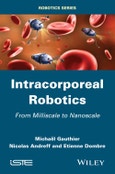A promising long-term evolution of surgery relies on intracorporeal microrobotics. This book reviews the physical and methodological principles, and the scientific challenges to be tackled to design and control such robots. Three orders of magnitude will be considered, justified by the class of problems encountered and solutions implemented to manipulate objects and reach targets within the body: millimetric, sub-millimetric in the 10- 100 micrometer range, then in the 1-10 micrometer range. The most prominent devices and prototypes of the state of the art will be described to illustrate the benefit that can be expected for surgeons and patients. Future developments nanorobotics will also be discussed.
Table of Contents
Introduction ix
Chapter 1. Intracorporeal Millirobotics 1
1.1. Introduction 1
1.2. Principles 2
1.2.1. Partially intracorporeal devices with active distal mobilities 2
1.2.2. Intracorporeal manipulators 5
1.2.3. Intracorporeal mobile devices 16
1.3. Scientific issues 20
1.3.1. Modeling 20
1.3.2. Design 24
1.3.3. Actuation and transmission 26
1.3.4. Sensing 30
1.3.5. Control 34
1.4. Examples of devices 37
1.4.1. The robotic platform of the Araknes project 39
1.4.2. A snake-like robot made of concentric super-elastic tubes 44
1.4.3. MICRON: a handheld robotized instrument for ophthalmic surgery 48
1.5. Conclusion 52
Chapter 2. Intracorporeal Microrobotics 55
2.1. Introduction 55
2.2. Novel paradigms for intracorporeal robotics 56
2.2.1. Classification of intracorporeal robots 56
2.2.2. Physical principles in use at microscale 57
2.3. Methods 66
2.3.1. Models 66
2.3.2. Design 71
2.3.3. Actuation 75
2.3.4. Sensing 80
2.3.5. Control 86
2.4. Devices 97
2.4.1. Magnetically guided catheters 97
2.4.2. Distal tip mobility for endoluminal microphonosurgery 98
2.4.3. Autonomous active capsules 102
2.4.4. Magnetically guided capsules 104
2.5. Conclusion 107
Chapter 3. In vitro Non-Contact Mesorobotics 109
3.1. Introduction 109
3.2. Principles 111
3.2.1. Introduction 111
3.2.2. Laser trapping 114
3.2.3. Electrostatic principles 118
3.3. Scientific challenges 122
3.3.1. Modeling 122
3.3.2. Design 129
3.3.3. Perception 131
3.3.4. Control 131
3.4. Experimental devices 132
3.4.1. Laser trapping 132
3.4.2. DEP systems 139
3.5. Conclusion 147
Chapter 4. Toward Biomedical Nanorobotics 149
4.1. Applicative challenges 149
4.1.1. In vitro applications 149
4.1.2. Nanoassembly for biomedical applications 150
4.1.3. In vivo applications 150
4.2. Scientific challenges 150
4.2.1. New paradigm removing frontiers between sciences 150
4.2.2. Energy sources 151
4.2.3. How far away is this future? 152
Bibliography 153
Index 183








